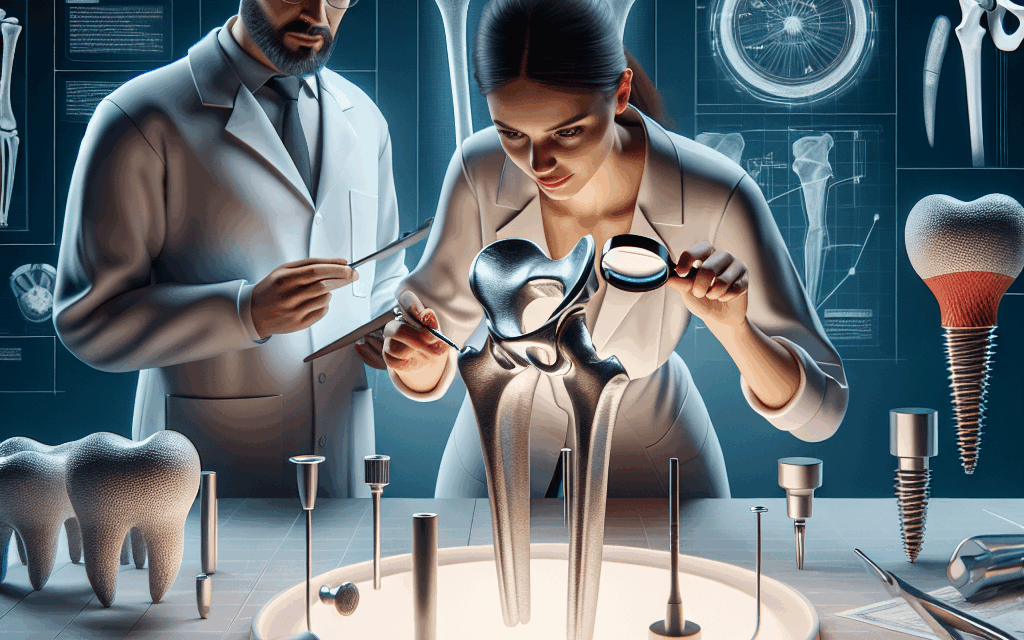Exploring the Role of Titanium in Medicine: Advantages, Applications, and Uses
Titanium, a transition metal known for its strength, low density, and corrosion resistance, has emerged as a pivotal material in the field of medicine. Its unique properties make it an ideal candidate for various medical applications, ranging from surgical implants to dental devices. This article delves into the multifaceted role of titanium in medicine, exploring its advantages, applications, and uses through five key subtopics.
1. The Unique Properties of Titanium
Titanium is renowned for its exceptional physical and chemical properties, which contribute to its widespread use in medical applications. Understanding these properties is crucial for appreciating why titanium is favored in the medical field.
1.1 Strength-to-Weight Ratio
Titanium boasts a remarkable strength-to-weight ratio, making it both strong and lightweight. This property is particularly beneficial in medical implants, where reducing the weight of devices can enhance patient comfort and mobility. For instance, titanium implants used in orthopedic surgeries can significantly reduce the overall weight of prosthetic limbs, allowing for better patient outcomes.
1.2 Corrosion Resistance
One of the standout features of titanium is its resistance to corrosion. This is particularly important in medical applications, where devices are often exposed to bodily fluids and varying pH levels. Titanium’s ability to form a protective oxide layer makes it highly resistant to corrosion, ensuring the longevity and reliability of implants and devices. Studies have shown that titanium implants can last for decades without significant degradation, making them a preferred choice for long-term applications.
1.3 Biocompatibility
Biocompatibility refers to the ability of a material to interact with biological systems without eliciting an adverse reaction. Titanium is highly biocompatible, which means it can be safely used in the human body without causing inflammation or rejection. This property is crucial for implants, as it ensures that the body accepts the foreign material. Research has demonstrated that titanium implants integrate well with bone tissue, promoting osseointegration and enhancing the stability of orthopedic devices.
1.4 Thermal Conductivity
While titanium has lower thermal conductivity compared to metals like copper or aluminum, its thermal properties are still advantageous in certain medical applications. For example, titanium’s ability to withstand high temperatures makes it suitable for surgical instruments that require sterilization. Additionally, its thermal stability ensures that implants maintain their integrity under varying temperature conditions.
1.5 Non-Magnetic Properties
Another significant advantage of titanium is its non-magnetic nature. This property is particularly important for patients who may require magnetic resonance imaging (MRI) after receiving implants. Unlike other metals, titanium does not interfere with MRI scans, allowing for accurate imaging and diagnosis. This non-magnetic characteristic has made titanium a preferred choice for various medical devices, including pacemakers and orthopedic implants.
2. Titanium in Orthopedic Applications
Orthopedic surgery is one of the most prominent fields where titanium is utilized. The material’s unique properties make it ideal for a range of orthopedic applications, including joint replacements, fracture fixation devices, and spinal implants.
2.1 Joint Replacement Implants
Titanium is widely used in joint replacement surgeries, particularly for hip and knee replacements. The material’s strength and biocompatibility allow for the creation of durable implants that can withstand the stresses of daily activities. For instance, titanium alloy femoral stems are commonly used in hip replacements, providing stability and support to the joint. Studies have shown that titanium implants can achieve high rates of success, with many patients experiencing significant improvements in mobility and quality of life.
2.2 Fracture Fixation Devices
In cases of bone fractures, titanium plates, screws, and rods are often employed to stabilize the broken bones during the healing process. The lightweight nature of titanium reduces the overall burden on the patient while providing the necessary strength to support the healing bones. Additionally, titanium’s biocompatibility ensures that these fixation devices do not cause adverse reactions, allowing for a smoother recovery process.
2.3 Spinal Implants
Titanium is also extensively used in spinal surgery, particularly for spinal fusion procedures. Titanium cages and rods are utilized to stabilize the spine and promote fusion between vertebrae. The use of titanium in spinal implants has been associated with improved outcomes, including reduced pain and enhanced mobility. Research indicates that titanium spinal implants have a lower rate of complications compared to other materials, further solidifying their role in orthopedic surgery.
2.4 Custom Implants and 3D Printing
The advent of 3D printing technology has revolutionized the production of titanium orthopedic implants. Custom implants can now be designed to fit the unique anatomy of individual patients, leading to improved surgical outcomes. For example, 3D-printed titanium implants can be tailored to match the specific contours of a patient’s bone structure, enhancing stability and integration. This personalized approach has shown promising results in clinical studies, with patients reporting higher satisfaction rates and faster recovery times.
2.5 Case Studies and Success Rates
Numerous case studies highlight the success of titanium in orthopedic applications. For instance, a study published in the Journal of Orthopedic Research reported a 95% success rate for titanium hip implants over a ten-year period. Similarly, research conducted on titanium spinal implants demonstrated a fusion rate of over 90%, indicating the material’s effectiveness in promoting bone healing. These statistics underscore the reliability of titanium in orthopedic surgery and its potential to improve patient outcomes.
3. Titanium in Dental Applications
The dental field has also embraced titanium for various applications, particularly in dental implants and prosthetics. The material’s biocompatibility and strength make it an ideal choice for restoring dental function and aesthetics.
3.1 Dental Implants
Titanium dental implants have become the gold standard for tooth replacement. These implants are surgically placed into the jawbone, where they integrate with the surrounding bone tissue through a process known as osseointegration. This integration provides a stable foundation for dental crowns, bridges, or dentures. Studies have shown that titanium dental implants have a success rate of over 95%, making them a reliable option for patients seeking tooth replacement.
3.2 Advantages Over Other Materials
Compared to other materials, such as stainless steel or ceramics, titanium offers several advantages in dental applications. Its biocompatibility ensures that patients experience minimal adverse reactions, while its strength allows for the creation of slender implants that can be placed in narrow spaces. Additionally, titanium’s corrosion resistance ensures that dental implants remain functional and aesthetically pleasing over time.
3.3 Customization and Aesthetic Considerations
Advancements in dental technology have enabled the customization of titanium implants to meet individual patient needs. Dentists can now design implants that match the color and shape of natural teeth, enhancing the overall aesthetic outcome. Furthermore, the use of computer-aided design (CAD) and computer-aided manufacturing (CAM) technologies allows for precise implant placement, improving the fit and function of dental restorations.
3.4 Case Studies in Dental Implant Success
Numerous case studies have documented the success of titanium dental implants. For example, a longitudinal study published in the International Journal of Oral & Maxillofacial Implants followed patients with titanium implants over a five-year period, reporting a success rate of 97%. These findings highlight the reliability of titanium in dental applications and its ability to restore function and aesthetics effectively.
3.5 Future Trends in Dental Titanium Applications
The future of titanium in dentistry looks promising, with ongoing research exploring new applications and technologies. Innovations such as surface modifications to enhance osseointegration and the development of bioactive titanium coatings are being investigated to further improve implant success rates. As the field of dentistry continues to evolve, titanium will likely remain at the forefront of dental implant technology.
4. Titanium in Cardiovascular Applications
Titanium’s role in cardiovascular medicine is expanding, with applications ranging from stents to pacemakers. The material’s unique properties make it suitable for devices that require both strength and biocompatibility.
4.1 Cardiovascular Stents
Titanium stents are used to treat narrowed or blocked arteries, providing support to keep blood vessels open. The biocompatibility of titanium ensures that these stents do not cause adverse reactions within the body. Additionally, titanium’s strength allows for the creation of thin-walled stents that can be easily deployed during minimally invasive procedures. Clinical studies have shown that titanium stents have lower rates of restenosis compared to traditional stainless steel stents, making them a preferred choice for many patients.
4.2 Pacemakers and Implantable Devices
Titanium is commonly used in the construction of pacemakers and other implantable cardiovascular devices. Its non-magnetic properties allow for safe MRI compatibility, which is crucial for patients requiring regular imaging. Furthermore, titanium’s corrosion resistance ensures the longevity of these devices, reducing the need for replacement surgeries. Research indicates that titanium pacemakers have a high success rate, with many patients experiencing improved quality of life following implantation.
4.3 Vascular Grafts
Titanium is also being explored for use in vascular grafts, which are used to bypass blocked arteries. The material’s strength and biocompatibility make it an attractive option for creating durable grafts that can withstand the pressures of blood flow. Ongoing research is focused on developing titanium-based grafts that promote better integration with surrounding tissues, further enhancing their effectiveness in treating cardiovascular conditions.
4.4 Case Studies in Cardiovascular Applications
Several case studies have highlighted the success of titanium in cardiovascular applications. For instance, a study published in the Journal of the American College of Cardiology reported a significant reduction in restenosis rates among patients treated with titanium stents compared to those with traditional stents. These findings underscore the potential of titanium to improve patient outcomes in cardiovascular medicine.
4.5 Future Directions in Cardiovascular Titanium Research
The future of titanium in cardiovascular applications is promising, with ongoing research exploring new materials and technologies. Innovations such as bioactive coatings and drug-eluting stents are being investigated to enhance the performance of titanium devices. As the field of cardiovascular medicine continues to advance, titanium will likely play a crucial role in developing new treatment options for patients.
5. Challenges and Considerations in Titanium Use
While titanium offers numerous advantages in medical applications, there are also challenges and considerations that must be addressed. Understanding these factors is essential for optimizing the use of titanium in medicine.
5.1 Cost Considerations
The cost of titanium can be a significant barrier to its widespread use in medical applications. Titanium is more expensive than other materials, such as stainless steel, which can limit its accessibility for certain patients and healthcare systems. However, the long-term benefits of titanium, including reduced complications and longer implant lifespan, may offset these initial costs. Ongoing research into cost-effective manufacturing processes may also help make titanium more accessible in the future.
5.2 Allergic Reactions and Sensitivities
Although titanium is generally considered biocompatible, some patients may experience allergic reactions or sensitivities to titanium implants. These reactions are rare but can lead to complications and implant failure. Healthcare providers must carefully assess patients’ medical histories and consider alternative materials for those with known sensitivities. Ongoing research is focused on understanding the mechanisms behind these reactions and developing strategies to mitigate them.
5.3 Regulatory Challenges
The regulatory landscape for medical devices can pose challenges for the approval and use of titanium-based products. Regulatory agencies require extensive testing and documentation to ensure the safety and efficacy of new devices. While titanium has a well-established track record in medicine, navigating the regulatory process can be time-consuming and costly for manufacturers. Collaboration between industry stakeholders and regulatory bodies may help streamline this process and facilitate the introduction of innovative titanium-based products.
5.4 Long-Term Outcomes and Monitoring
Long-term outcomes of titanium implants are crucial for assessing their effectiveness and safety. While many studies report high success rates, ongoing monitoring and data collection are essential to identify potential complications and improve patient care. Healthcare providers must remain vigilant in tracking patients with titanium implants, ensuring that any issues are addressed promptly. Additionally, long-term studies are needed to further understand the durability and performance of titanium in various medical applications.
5.5 Future Research Directions
Future research on titanium in medicine should focus on addressing the challenges outlined above while exploring new applications and technologies. Innovations such as surface modifications to enhance osseointegration, the development of bioactive coatings, and the use of 3D printing for custom implants are promising areas of investigation. Collaborative efforts between researchers, manufacturers, and healthcare providers will be essential for advancing the field and optimizing the use of titanium in medical applications.
Conclusion
Titanium has established itself as a cornerstone material in medicine, offering numerous advantages across various applications, including orthopedics, dentistry, and cardiovascular medicine. Its unique properties, such as strength, corrosion resistance, and biocompatibility, make it an ideal choice for medical implants and devices. While challenges remain, ongoing research and innovation continue to enhance the role of titanium in medicine.
As we look to the future, it is clear that titanium will play a crucial role in advancing medical technology and improving patient outcomes. By addressing challenges related to cost, allergic reactions, and regulatory hurdles, the medical community can fully harness the potential of titanium to enhance healthcare delivery and patient care.
In summary, titanium’s versatility and reliability make it an invaluable asset in the medical field, paving the way for continued advancements in treatment options and patient care.





